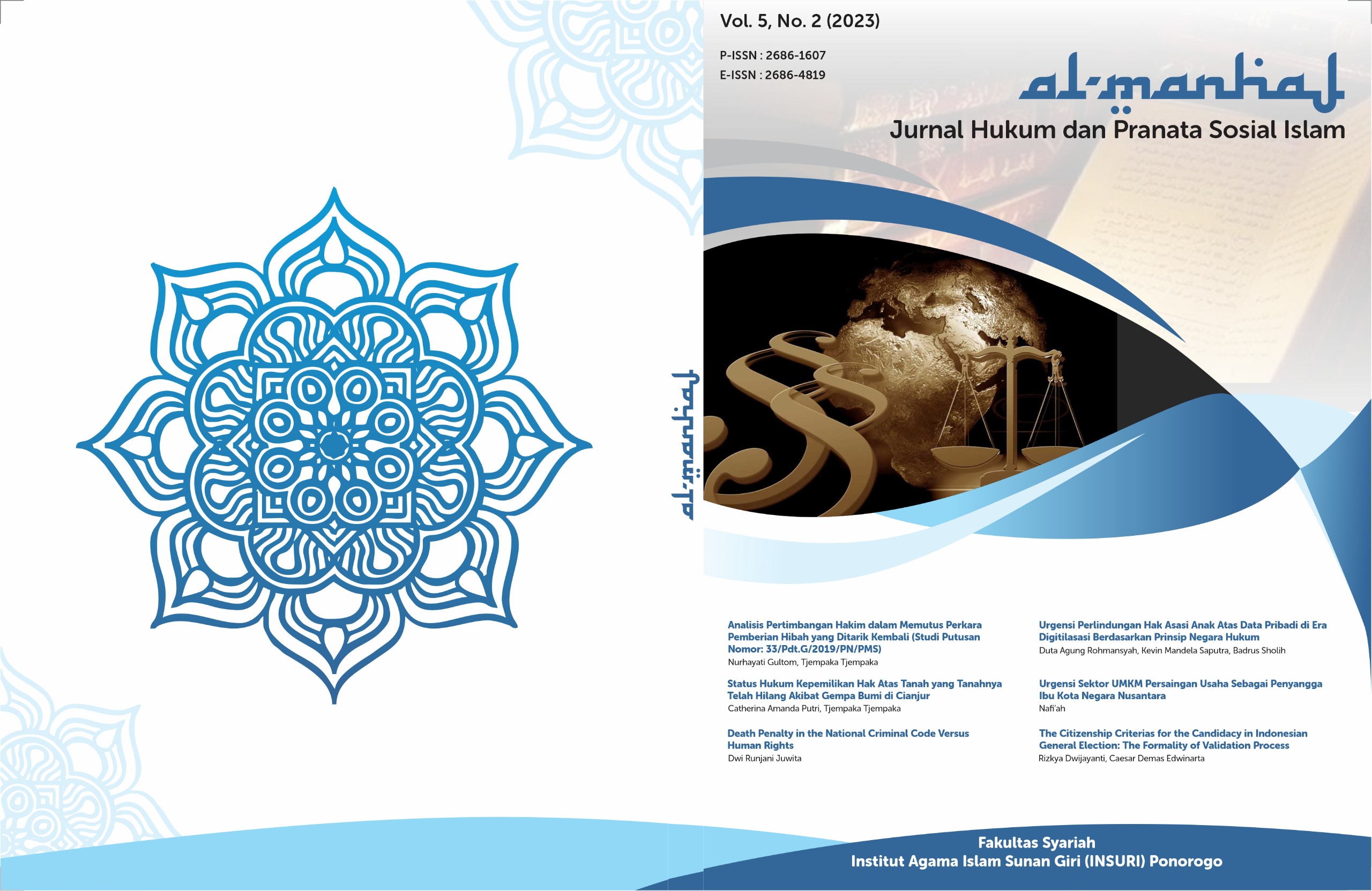Fungsi dan Peran Notaris Pada Peralihan Hak Atas Merek Melalui Perjanjian Jual-Beli
DOI:
https://doi.org/10.37680/almanhaj.v5i2.3382Keywords:
Brand; Notary; Authentic DeedAbstract
A brand is a manifestation of a trade or service business. Apart from that, a brand is also an intangible object whose ownership can be transferred by transferring the rights to the brand through a notary. The role of the Notary in question is in making the brand transfer deed. Through this research, the authors aim to find out and examine how the function and role of a notary is in making a deed of transfer of rights to a brand through a sale-purchase agreement. In reviewing this journal, the author uses primary and secondary legal materials with a conceptual approach and applies normative juridical research methods which are carried out by examining the theories, concepts and laws and regulations concerned. The results of this study note that according to Law Number 20 of 2016 Concerning Trademarks and Geographical Indications Notarial (authentic) deed in transferring rights to a trademark through a sale-purchase agreement is not an obligation but can be used as an option or alternative. Notarial (authentic) deed has the best binding and evidentiary power, therefore a sale and purchase agreement using a Notarial deed is the best choice. Furthermore, the role of the Notary in terms of transferring rights to the mark through an agreement or sale is to provide understanding and legal protection by making authentic deeds which aim to provide legal certainty to the parties.
References
Fatmawati, A. Winarno, B. Sudjito, B. (2015). Tinjauan Yuridis Terhadap Fungsi Notaris Dalam Peralihan Hak atas Merek. Malang: Program Studi Magister Kenotariatan Fakultas Hukum Universitas Brawijaya.
Febriani, M., P. (2016). Eksistensi Hak Atas Kekayaan Intelektual Terhadap Hukum Siber. Jurnal Ilmiah. Volume 5 Nomor 1
Panduan, H. K. I. (2008). Membangun Usaha Kecil-Menengah berbasis Pendayagunaan Sistem Hak kekayaan Intelektual, Ditjen HKI, Asian Pasific Economic Coorporation dan IPAustralia. Tangerang: Ditjen HKI.
Merek. 2022. Pada KBBI Daring. Diambil 16 Juni 2023, dari https://kbbi.kemdikbud.go.id/entri/Merek
Rahayu, K. Rizkianto, K. Mukhidin, (2022). Peran Jabatan Notaris dalam Pembuatan Akta Pengalihan Hak Atas Merek. Kosmik Hukum Fakultas Hukum Universitas Muhammadiyah Purwokerto, Volume 22, Nomor 2.
Rahmi, J. (2013). Interface Hukum Kekayaan Intelektual dan Hukum Persaingan (Penyalahgunaan HKI). Jakarta: Raja Grafindo Persada.
Sasauw, C. (2015). Tinjauan Yuridis tentang Kekuatan Mengikat suatu Akta Notaris. Jurnal Lex Privatum Volume 3. Nomor 1.
Saidin, OK. (2003). Aspek Hukum Hak Kekayaan Intelektual (Intellectual Property Rights). Jakarta: PT. Raja Grafindo Persada
Simanjuntak, I. AJ. Henny, M. (2022). Peran Pertanggungjawaban Notaris atas Perjanjian Lisensi Merek di Indonesia. Jurnal Legislasi Indonesia. Volume 19. Nomor 1.
Sutedi, A. (2010). Peralihan Hak atas Tanah dan Pendaftarannya. Jakarta: Sinar Grafika.
Sumini, Purnawan, A. (2017). Peran Notaris dalam Membuat Akta Perjanjian Notariil, Jurnal Akta. Volume 4. Nomor 4.
Lindsey, Tim. et.al. (2006). Hak Kekayaan Intelektual (Suatu Pengantar). Bandung: Alumni.
Tobing, G.H.S Lumban. (1980). Peraturan Jabatan Notaris. Jakarta: Erlangga.
Toguan, Z. (2021). Problematika Hak Kekayaan Intelektual Di Bidang Merek Bagi Pelaku Usaha Mikro Kecil Menegah. UIRLawReview, 1-15.
Yahanan, A. Elmadiantini. (2019). Akta Nitaril: Keharusan atau Pilihan Dalam Peralihan Kekayaan Intelektual. Lambung Mangkurat Law Journal. Volume 4. Nomor 1.
Kitab Undang-Undang Hukum Perdata
Undang-Undang No. 30 Tahun 2000 Tentang Rahasia Dagang
Undang-Undang No. 31 Tahun 2000 Tentang Desain Industri
Undang-Undang Nomor 32 Tahun 2000 Tentang Desain Tata Letak Sirkuit Terpadu
Undang-Undang Nomor 2 Tahun 2014 Tentang Jabatan Notaris
Undang-Undang No. 28 Tahun 2014 Tentang Hak Cipta
Undang-Undang Nomor 20 Tahun 2016 tentang Merek dan Indikasi Geografis
Peraturan Menteri Hukum dan Hak Asasi Manusia No. 67 tahun 2016 tentang Pendaftaran Merek
Peraturan Menteri Hukum dan Hak Asasi Manusia Nomor 8 Tahun 2016 Tentang Syarat dan Tata
Cara Permohonan Pencatatan Perjanjian Lisensi Kekayaan Intelektual
Downloads
Published
How to Cite
Issue
Section
License
Copyright:
- Author retains the copyright and grants the journal the right of first publication of the work simultaneously licensed under a Creative Commons Attribution 4.0 International License that allows others to share the work with an acknowledgment of the work's authorship and initial publication in this journal.
- Author is able to enter into separate, additional contractual arrangements for the non-exclusive distribution of the journal's published version of the work (e.g., post it to an institutional repository or publish it in a book) with the acknowledgment of its initial publication in this journal.
- Author is permitted and encouraged to post his/her work online (e.g., in institutional repositories or on their website) prior to and during the submission process, as it can lead to productive exchanges, as well as earlier and greater citation of the published work (See The Effect of Open Access).
License:
-
Attribution — You must give appropriate credit, provide a link to the license, and indicate if changes were made. You may do so in any reasonable manner, but not in any way that suggests the licensor endorses you or your use.
-
No additional restrictions — You may not apply legal terms or technological measures that legally restrict others from doing anything the license permits.
You are free to:
- Share — copy and redistribute the material in any medium or format
- Adapt — remix, transform, and build upon the material for any purpose, even commercially.

This work is licensed under a Creative Commons Attribution 4.0 International License.














